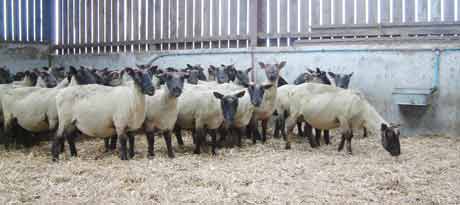Cambridge offers prolificacy and performance for Welsh sheep unit

The Cambridge, a breed created with high prolificacy to increase returns for commercial producers, may have fallen from favour in terms of its ability to lift lambing percentages.
But a north Wales sheep farmer has spent more than 20 years developing his own strain of the breed and now uses it as part of a hard-wearing commercial crossbred.
Gwyn Buckley, with his brother Richard and Richard’s sons Paul and John, runs 1000 ewes alongside 80 milkers at Cefn Isaf, Llangedwyn, Oswestry. The main thrust of his prime lamb output comes from Texel x Cambridge ewes, a cross he says that has tremendous durability, retains a degree of the Cambridge breed’s prolificacy and produces “top spec” lambs for the deadweight and liveweight trade.
“I don’t want a ewe that produces four lambs or more, that would be impractical. But when we first tried the purebred Cambridge more than 25 years ago we were convinced the breed had a lot of commercial virtues and we stuck with it. But over time we’ve selected against ewes with very high prolificacy,” says Gwyn Buckley.
The Cambridge was originally bred at Liverpool University by Allan Davies, who, although now retired, still runs his own flock and acts as breed secretary to a small band of stalwart supporters.
The 162ha (400-acre) Cefn Isaf is a hill farm running to 1000ft. The land is dry and south facing giving a welcome early bite of grass in a normal spring. The farm also finishes about 65 beef cattle a year and has a flock of 100 purebred Charollais.
Originally, it carried Speckled-face ewes put to Suffolk tups, but in the late 1970s the need to lift lamb output sent the Buckley brothers out to look at other breeds.
“We set up a small flock of Cambridge and also put Cambridge tups on the Speckled face ewes to produce a half-bred and by the early 1980s we were getting 200% lambing from this cross,” recalls Mr Buckley. Although he says the ram lambs from the Cambridge x Speckled face weren’t achieving the prime lamb quality they demanded.
Gradually the purebred Cambridge flock increased, concentrating on ewes from families that weren’t extreme in terms of prolificacy. Texel, Charollais and Suffolk rams were tried as the brothers sought to breed a commercial ewe based on the Cambridge.
“We were convinced she had a lot to offer and it soon became clear that the Texel x Cambridge was a commercial cross that gave us what we wanted in terms of the conformation quality of her prime lamb as well as being easily managed and a hard wearer.”

Purebred Cambridge sheep lift prolificacy, with other positive traits like conformation easy to select for
There are now 200 purebred Cambridge ewes on the farm. But with some ewes capable of achieving a lambing percentage nudging 240%, there is strict policy of selecting females with considerably less fecundity. No pure Cambridge lambing anything above triplets is retained. About 150 of the pure Cambridge provide Texel-cross females for the main commercial flock.
“The Texel x Cambridge is slightly smaller than a Mule ewe, with mature females weighing 70-80kg. She’s quiet, holds her condition exceptionally well, is a good mother and has trouble-free feet.
“All told she does the job we want from a commercial ewe and produces the high quality prime lambs we need. The Texel influence gives you flexibility and hardiness. We lamb some as hoggs anything over 36kg goes to the tup.”
The Buckley’s prime lambs are sold between September and February. Half are sold deadweight to Waitrose with the rest going live through Oswestry market.
“The Texel x Cambridge – even the yearlings – give us 180-190% lambing. They are good, milky mothers and as well as their good feet they hold their teeth, too. We easily get ewes still breeding at five shear and have some ewes at eight and nine years old still in the flock.
“Although we’re producing our own flock replacements, this level of wearability is a cost-saving trait that makes a big difference.”
While purebred Cambridge ewes lamb in mid-March, the main Texel x Cambridge flock, put to Charollais rams, lambs from early April. The flock is housed and sheared early in the New Year. Lambs are weaned by the end of July. A typical batch of Charollais-sired lambs out of the Texel x Cambridge ewes sold in mid-January this year saw prices average £74 a head for a batch of 40 lambs averaging 40kg and £80 a head for another five lambs averaging 48kg.
“The Cambridge was a breed created primarily to lift prolificacy, but we’ve concentrated on the breed’s other positive traits and have selected for conformation as a priority. Put to the Texel, the Cambridge produces a cross-bred ewe that suits us well and particularly on this type of farm, where some ewes can lose condition quickly if the land dries up.”
